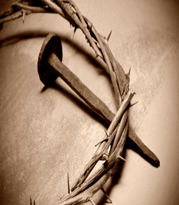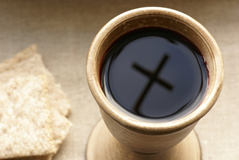by Racquel Ray, Assoc. Minister (Acting)
The Triduum, Three Holy Days, are for me the most sacred days of the liturgical year. Maundy Thursday, Good Friday, and Holy Saturday are considered one continuous liturgy in remembrance of the Passion of Jesus.
Each Christian denomination has their own tradition around Holy Week which consists of the days from Palm Sunday to Easter Sunday. The traditions mark Jesus’ return to Jerusalem wherein the crowd lays branches and cloaks along the road Jesus travels on a donkey; the remembrance of Jesus driving the money changers out of the Temple; the chief priest and scribes questioning Jesus’ authority and conspiring against him; the anointing of Jesus’ feet by a woman unnamed in two of the Gospels, a sinner in another Gospel, and Mary of Bethany according to John’s Gospel; the institution of the Communion meal as Jesus shared the Passover supper with his disciples; the watch and prayer in the Garden; Jesus’ arrest and trial; Jesus’ torture, crucifixion, death, and burial; the silence of Holy Saturday; and the Easter Morning earthquake at sunrise, the stone rolling away, and the empty tomb. The Triduum specifically recalls the Three Days from Thursday to Saturday of Holy Week.
 Holy Thursday or Maundy Thursday remember Jesus’ commencement of the Communion, the night of Jesus’ washing the Disciples’ feet, and Jesus’ prayers in the Garden of Gethsemane while the Disciples tried to keep watch. Jesus’ violent ambush and arrest narrative are part of the lectionary. Some traditions will add a community foot washing to the worship service on the Thursday of Holy Week. In past ministry contexts, I have washed the feet of nearly 100 youth, recently diagnosed cancer patients, or washed the hands of seniors and healthcare workers in the nursing home during the pandemic.
Holy Thursday or Maundy Thursday remember Jesus’ commencement of the Communion, the night of Jesus’ washing the Disciples’ feet, and Jesus’ prayers in the Garden of Gethsemane while the Disciples tried to keep watch. Jesus’ violent ambush and arrest narrative are part of the lectionary. Some traditions will add a community foot washing to the worship service on the Thursday of Holy Week. In past ministry contexts, I have washed the feet of nearly 100 youth, recently diagnosed cancer patients, or washed the hands of seniors and healthcare workers in the nursing home during the pandemic.
 Holy Friday or Good Friday recall the events of Jesus’ trial before the crowd, the chief priests and the elders, the Roman Governor Pontius Pilot, and the Jewish King Herod. The crowds asked for the release of Barabbas not Jesus and calling for Jesus to be crucified. Jesus receiving a scarlet robe and crown of thorns from the Roman soldiers who taunted, “Hail, King of the Judeans!” Jesus’ carrying of the cross being offered assistance from Simon of Cyrene. Some traditions will observe the events with a Way of the Cross service or Stations of the Cross following Biblical and extrabiblical traditions of Jesus journey from Jerusalem to Golgotha.
Holy Friday or Good Friday recall the events of Jesus’ trial before the crowd, the chief priests and the elders, the Roman Governor Pontius Pilot, and the Jewish King Herod. The crowds asked for the release of Barabbas not Jesus and calling for Jesus to be crucified. Jesus receiving a scarlet robe and crown of thorns from the Roman soldiers who taunted, “Hail, King of the Judeans!” Jesus’ carrying of the cross being offered assistance from Simon of Cyrene. Some traditions will observe the events with a Way of the Cross service or Stations of the Cross following Biblical and extrabiblical traditions of Jesus journey from Jerusalem to Golgotha.
Holy Saturday or Easter Saturday is a day of emptiness. The one day of the liturgical year when Jesus is no longer with us. As Traci Blackmon said, “Jesus has left the building.” The loneliness of Holy Saturday is palpable. After having journeyed through the active six weeks of Lent; the Sunday morning worship services conscientiously curated with colorful thought-provoking themes, to contemplative Tuesday and Thursday morning Peaceful Pause and Prayer, to full-sensory Lent in the Labyrinth prayer walks, and awareness raising Bible Studies, Holy Saturday leaves a hollow and holy stillness. “He is not here.”
 The Triduum holds sacred significance for me personally and has greatly enriched my ministerial role. I was confirmed on Maundy Thursday in 1978. I remember the red carpet and dark wood of Church of our Saviour, the smell of frankincense, and the anointing oil of the Bishop as he made the mark of the cross on my forehead and laid hands on my head. I recall years of kneeling on the various shades of church carpets (usually either dark red or light blue), adding drops of lavender oil to the warm water (always make sure the water is warm), checking the stacks of clean towels. I can hear the music of Taize hymns and see the tears of congregation members as they overcome their insecurities to bare one or two feet, sharing in this sacred and intimate ritual with their ministers.
The Triduum holds sacred significance for me personally and has greatly enriched my ministerial role. I was confirmed on Maundy Thursday in 1978. I remember the red carpet and dark wood of Church of our Saviour, the smell of frankincense, and the anointing oil of the Bishop as he made the mark of the cross on my forehead and laid hands on my head. I recall years of kneeling on the various shades of church carpets (usually either dark red or light blue), adding drops of lavender oil to the warm water (always make sure the water is warm), checking the stacks of clean towels. I can hear the music of Taize hymns and see the tears of congregation members as they overcome their insecurities to bare one or two feet, sharing in this sacred and intimate ritual with their ministers.
 I recall years of Good Friday Stations of the Cross and Way of the Cross services. I remember ecumenical services where several Pastors and Priests shared the readings at each station, the quiet self-guided stations, the small group noon day services with a few devoted worshippers, the huge Youth Group stations productions with dozens of youth acting out the fourteen stations and running behind the scenes. I remember the hallways and closets filled with the rich smells of the Easter Sunday flowers hidden and ready for arrangement in a day. I remember years of banning television in our home on Good Friday. And, I recall the lost Good Friday – the service I had planned at seminary my senior year that was cancelled due to covid in March 2020 – a walking Stations of the Cross through the quad of the Divinity School.
I recall years of Good Friday Stations of the Cross and Way of the Cross services. I remember ecumenical services where several Pastors and Priests shared the readings at each station, the quiet self-guided stations, the small group noon day services with a few devoted worshippers, the huge Youth Group stations productions with dozens of youth acting out the fourteen stations and running behind the scenes. I remember the hallways and closets filled with the rich smells of the Easter Sunday flowers hidden and ready for arrangement in a day. I remember years of banning television in our home on Good Friday. And, I recall the lost Good Friday – the service I had planned at seminary my senior year that was cancelled due to covid in March 2020 – a walking Stations of the Cross through the quad of the Divinity School.
And Holy Saturday. Holy Saturday is the theological place where Chaplains abide. The sacred space between what was and what is yet to be. This is the realm of the Chaplain’s ministry of accompaniment. Author Shelly Rambo writes in Spirit and Trauma; A Theology of Remaining that new life arises from death. The Holy Saturday moment of remaining, of being present in the space between death of Good Friday and the new life of Easter reminds us of our need to be there for each other. Chaplains are particularly and sacredly skilled in remaining in this sacred place with others and building the spiritual bridges others need to traverse the emptiness of Saturday times.
 As Christians we do ourselves a disservice when we jump too quickly to resurrection. Though we love the Good News of New Life, we do need the walk of darkness to see the light sometimes. It is not to say that we must suffer to be Holy. It is to say that the deeper we walk in the biblical remembrances of Holy Week the more we understand and appreciate Jesus’ words, “It is finished.” And the more we understand Jesus work the more we can rejoice with Mary Magdalene, Joanna, Mary the mother of James, and the other women who told all the apostles, “He is Risen”.
As Christians we do ourselves a disservice when we jump too quickly to resurrection. Though we love the Good News of New Life, we do need the walk of darkness to see the light sometimes. It is not to say that we must suffer to be Holy. It is to say that the deeper we walk in the biblical remembrances of Holy Week the more we understand and appreciate Jesus’ words, “It is finished.” And the more we understand Jesus work the more we can rejoice with Mary Magdalene, Joanna, Mary the mother of James, and the other women who told all the apostles, “He is Risen”.



